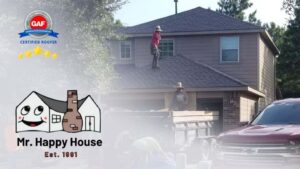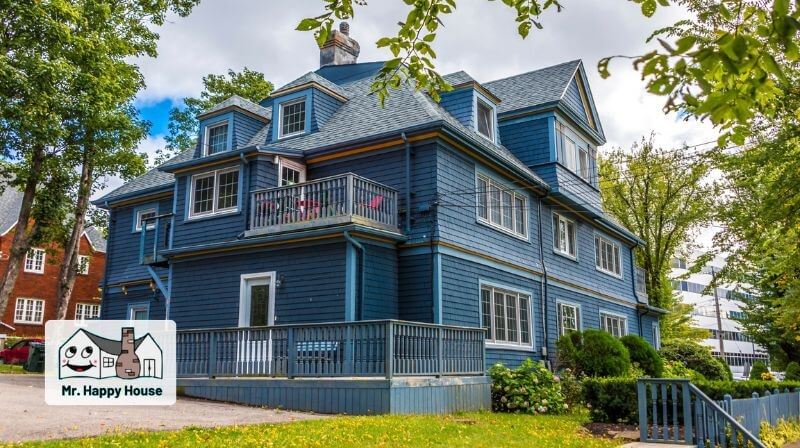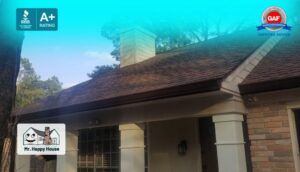
Best GAF Certified Roofers in The Woodlands, TX – Quality Roof Replacement, Gutters & Siding
Best GAF Certified Roofers in The Woodlands, TX – Quality Roof Replacement, Gutters & Siding Best GAF Certified Roofers in The Woodlands, TX – Quality

Siding isn’t just about aesthetics; it’s a protective shell for your house, shielding it from the elements and defining its character. Traditional wood siding and engineered wood siding stand as some popular choices for home siding.
In this article, we’ll take you on a journey through the world of wood siding, exploring situations where you might be able to use wood siding on your home and giving you the best alternatives for a long lasting siding job. We’ll break down the characteristics, benefits, drawbacks, and eco-friendliness of each option, offering you a comprehensive guide to make an informed choice that suits your unique needs and preferences.
So, whether you’re an architect, a contractor, or a homeowner with a vision, join us as we dive into the fascinating comparison of Traditional Wood Siding and Engineered Wood Siding, providing you with the insights you need to transform your home into a sanctuary that blends style with functionality and sustainability.
When we think of classic charm and time-tested elegance, traditional wood siding immediately comes to mind. This tried-and-true siding option has been adorning homes for centuries and continues to be a popular choice for those who appreciate the natural beauty of wood. Let’s dive into what makes traditional wood siding unique and the factors to consider when contemplating this timeless choice.
Traditional wood siding, as the name suggests, consists of wooden boards or shingles that are installed on the exterior of a building. These boards can be made from various wood species, with cedar, pine, and redwood being among the most common choices. The character of traditional wood siding is marked by the individuality of each piece of wood, showcasing its grain patterns, knots, and warm, earthy tones.
Natural Beauty: Traditional wood siding exudes natural beauty and warmth, offering a timeless and authentic appearance that complements various architectural styles.
Environmental Friendliness: When sourced responsibly, wood siding can be a sustainable choice, and it’s biodegradable, making it an eco-friendly option.
Maintenance: Traditional wood siding requires regular maintenance, including staining or painting and protection against pests, rot, and moisture. Failure to do so can lead to deterioration over time.
Cost: While the initial cost may be reasonable, the long-term expenses associated with maintenance can add up, such as regular house painting and siding repairs, making it a potentially expensive option.
Vulnerability to Elements: Traditional wood siding is susceptible to damage from moisture, pests, and extreme weather conditions. Proper installation and ongoing care are crucial to extend its lifespan.
Traditional wood siding is more than just an exterior covering; it’s a testament to the enduring beauty of nature and architectural heritage. However, its unique character comes with responsibilities, making it essential to weigh the pros and cons when considering this siding option for your project. In the following sections, we’ll explore the contemporary alternative, engineered wood siding, and help you make an informed decision for your next construction or renovation project.
In an era where innovation meets sustainability, engineered wood siding has risen to prominence as a versatile and environmentally conscious alternative to traditional wood siding. Let’s talk about the advantages, drawbacks, and overall characteristics of engineered wood siding.
Engineered wood siding, often referred to as composite wood siding, is a modern building material that combines wood fibers, resins, and other additives to create a cost-effective and eco-friendly siding option. It is designed to mimic the natural look of wood while enhancing its performance and longevity. The primary types of engineered wood siding include fiber cement, oriented strand board (OSB), and plywood.
Cost-Effectiveness: The initial cost is generally lower than traditional wood siding, and the reduced maintenance expenses can make it a budget-friendly choice in the long run.
Versatility: Engineered wood can be tailored to imitate various wood species and styles, offering flexibility in design and aesthetics.
Appearance: While engineered wood does an impressive job replicating the look of wood, some purists may argue that it lacks the genuine warmth and authenticity of natural wood.
Environmental Concerns: Although engineered wood is generally considered eco-friendly, the production processes and additives used can impact its sustainability. Be sure to research brands and products that prioritize green practices.
Durability: The durability of engineered wood siding for the long term should be taken into consideration. At Mr. Happy House, we come across many homes in the Houston area that have engineered wood siding on their home and for many areas to be rotted and deteriorated. One thing to note is engineered wood siding isn’t a good option if your home is located in a hot and humid climate.
Now that we’ve explored the individual qualities of traditional wood siding and engineered wood siding, let’s embark on a side-by-side comparison to help you make an informed decision for your project. We’ll analyze various aspects such as cost, durability, maintenance, and aesthetics to provide you with a comprehensive understanding of these two siding options.
Traditional Wood Siding: The initial cost of traditional wood siding is typically higher than engineered wood siding due to the materials and labor involved. However, long-term maintenance costs can significantly impact the overall expense.
Engineered Wood Siding: Engineered wood siding is often more cost-effective initially. While it may not have the same authentic appeal as natural wood, it offers a budget-friendly alternative with lower maintenance costs over time.
Traditional Wood Siding: Traditional wood siding, when properly maintained, can last for decades. However, it is more vulnerable to pests, rot, and moisture, which can decrease its longevity.
Engineered Wood Siding: Engineered wood siding is engineered to resist moisture and pests, providing a longer lifespan and reduced maintenance requirements. It is a durable choice for regions with challenging weather conditions.
Traditional Wood Siding: Requires regular maintenance, including staining or painting every few years, as well as protection against termites and moisture. Neglecting maintenance can lead to premature deterioration.
Engineered Wood Siding: Generally requires minimal maintenance, as it often comes pre-finished with protective coatings. Periodic cleaning and inspections are usually sufficient to keep it in good condition for the first few years.
Traditional Wood Siding: Embraces the natural beauty of wood with its unique grain patterns, knots, and warmth. It offers a timeless and authentic appearance that many homeowners find appealing.
Engineered Wood Siding: While engineered wood does an admirable job imitating the look of natural wood, some may argue that it lacks the genuine warmth and authenticity of the real thing. However, it offers versatility in design and a consistent appearance.
Traditional Wood Siding: Can be a sustainable choice when sourced responsibly from well-managed forests. It is biodegradable and has a lower carbon footprint than many other building materials.
Engineered Wood Siding: Engineered wood can be environmentally friendly, especially when it uses recycled wood fibers and sustainable practices. However, the production processes and additives should be considered for their environmental impact.
Proper installation and maintenance are critical factors to consider when choosing between traditional wood siding and engineered wood siding. Let’s explore the requirements and considerations for each siding type in this section.
Traditional Wood Siding: Installing traditional wood siding involves skilled carpentry. The wooden boards or shingles are typically nailed or screwed onto the exterior walls. Proper sealing and waterproofing are essential to prevent moisture infiltration.
Engineered Wood Siding: Engineered wood siding installation is often more straightforward and can be done by experienced contractors. It may come in larger sheets or panels, making installation faster and more cost-effective.
Traditional Wood Siding: Traditional wood siding demands ongoing maintenance. It should be inspected for signs of rot, pests, and moisture damage regularly. Re-staining or repainting is typically required every few years to preserve its appearance and integrity.
Engineered Wood Siding: Engineered wood siding is designed for reduced maintenance. It often comes pre-finished with protective coatings that can last for many years. Periodic cleaning and inspections are usually sufficient.
Traditional and engineered wood siding can perform well in various climates but will require more frequent maintenance in regions with high humidity or extreme weather conditions.
Understanding the installation and maintenance requirements for both siding options is crucial to ensure their longevity and performance. Keep these considerations in mind as you make your decision.
In the world of exterior siding, the choice between traditional wood and engineered wood siding is a decision that holds great significance. Each option brings its own unique strengths and considerations, making the selection process a crucial step in your construction or renovation project.
Traditional wood siding, with its timeless charm, celebrates the inherent beauty of natural wood. Its authentic appearance, sustainability when sourced responsibly, and the warmth it brings to a home are attributes that have captivated homeowners and builders for generations. However, it comes with responsibilities in the form of regular maintenance, potential cost implications, and vulnerability to environmental elements.
The decision between the two must be made with a keen eye on your specific project’s needs, location, budget, and sustainability goals. There’s no one-size-fits-all answer, as both traditional and engineered wood siding have their own merits and limitations.
In the end, the perfect siding choice is one that aligns with your vision for your home and your individual circumstances. Both traditional wood siding and engineered wood siding are not good long term options if you plan to stay in your home for many years to come.
We hoped you loved this article on traditional wood siding vs engineered wood siding, please share and tune in for more roofing, siding, and house painting content!
Our Services:













Best GAF Certified Roofers in The Woodlands, TX – Quality Roof Replacement, Gutters & Siding
Best GAF Certified Roofers in The Woodlands, TX – Quality Roof Replacement, Gutters & Siding Best GAF Certified Roofers in The Woodlands, TX – Quality

Are Gutters Part of the Roofing System?
Are Gutters Part of the Roofing System? Are Gutters Part of the Roofing System? When it comes to home maintenance, gutters often seem like a

Why James Hardie is The Best Option for Home Siding
Why James Hardie is The Best Option for Home Siding Why James Hardie is The Best Option for Home Siding James Hardie stands out whether











